皮皮劳蒂·里斯特(Pipilotti
Rist) 1962年生于瑞士Grabs,现在苏黎世和诺恩堡生活工作。
皮皮劳蒂·里斯特说:“通过情绪和感官刺激所传递的信息会改变人们的偏见和原有的行为方式,它的力量将远远地超过了无数的图书和文章。”
视像艺术家皮皮劳蒂·里斯特的作品是闪烁的、色彩斑斓的,自信的和无所顾忌的。凭着这种自信和藐视一切世俗规范的精神,她迅速地征服了国际艺坛。她的成功充分证明,在大众音乐视像产品盛行的时代,艺术性的视像作品依然具有强大的竞争力。由于多年的乐手经历,她深知大众文化的审美趣味,并发现这种审美趣味在90年代初期的美术作品中没有得到充分的揭示和表现。起初,她那刺耳的录像作品似乎显得很平庸,过分强调戏剧性效果,满是异想天开的情节与图像。她常常现身于作品中,但并不成其为核心。里斯特曾说她要“在文学和它的美术衍生物之间挑起一场战争”。在1994年创作的“房间”中,里斯特用视象语言明确了表达了她对前辈的看法。几个巨大的红色扶手椅围绕在一个小型电视机的身边,成年人转动的眼睛和孩子们好奇的圆圆的眼睛充满了整个画面。随着创作的日益深入,深刻的现实问题越来越多地出现在她的作品中。1997年里斯特带来了具有深刻含义的作品“一切都成往事”。其中一个投影表现了一个青年女子欢快地在大街上奔跑的情景。同时展出的另一个投影展现的是,在一片鲜花盛开的草地上,一个警察正在满怀激情地迎接一个回头的浪子的到来。里斯特的视象语言传达出了比文字更强烈的信息力量。
简历:
Elisabeth Charlotte Rist was
born in 1962 in Grabs, Sankt Gallen, in Switzerland. Since her childhood
she has been nicknamed Pipilotti. The name refers to the novel Pippi Longstocking
by Astrid Lindgren.
Rist studied at the Institute of Applied Arts in Vienna, through 1986.
She later studied video at the School of Design (Schule für Gestaltung)
in Basel, Switzerland. In 1997m her work has been featured in the Venice
Biennial for the first time, where she was prized with the Premio 2000.
1998 through 1994 she was member of the music band and performance group
Les Reines Prochaines. In 2002 she was invited by Professor Paul McCarthy
to teach at UCLA.
Pipilotti Rist currently lives with her common law partner Balz Roth,
with whom she has a son, Himalaya.
In the United States, Rist is represented by the Luhring Augustine Gallery
in New York City. In Europe she is represented by Hauser & Wirth,
of London and Zurich. Her work is held by very respectable museums and
collectors around the world.
作品:
In I'm Not The Girl Who Misses
Much (1986) Rist shows how she dances before a camera in a black dress
with uncovered breast and red lips. The images are monochromatic and fuzzy.
Rists sings "I'm not the girl who misses much." Her version
of the first line of the song Happiness Is a Warm Gun by John Lennon -
"She's not a girl who misses much". In the end, the image becomes
blue and more and more fuzzy; the sound stops.
Rist became famous worldwide with Pickelporno (1992), a work about the
female body and the sexual exitation. The fish eye camera moves close
to the bodies of a couple. The images are covered by intensive colors,
to be perceived strangely, sensually, and ambigously by the spectator.
Ever is Over All (1997) shows in slow-motion a young woman that smashes
tropical flower in the glasses of parked cars. A policewoman narrows her
and greets her. The clip has been purchased by the Museum of Modern Art
of New York City.
The six-teen Open My Glade videoclips were played once every hour on
a screen at Times Square in New York City, an initiative of the Messages
to the Public program, which exists since 1980.
影片,影像,影像装置作品列表:
1984 - St. Marxer Friedhof
(Sankt Marx Cemetery) - 4 minutes
1986 - Das Gute (The Good) - 9 minutes.
1986 - I'm Not The Girl Who Misses Much - 7:45 minutes.
1987 - Sexy Sad I - 4:36 minutes
1988 - (Entlastungen) Pipilottis Fehler ((Discharges) Pipilottis Mistakes)
- 11:10 minutes
1988 - Japsen. With Muda Mathis - 12 minutes
1989 - Die Tempodrosslerin saust. With Muda Mathis - 14 mit
1990 - You Called Me Jacky - 4 minutes
1992 - Pickelporno - 12 minutes
1992 - Als der Bruder meiner Mutter geboren wurde, duftete es nach wilden
Birnenblüten vor dem braungebrannten Sims (When My Mother's Brother Was
Born, It Smelt of Pear Flowers Before the Brown Cornice) - 4 minutes
1992 - Blue Bodily Lettre
1993 - Blutclip - 2:50 minutes
1994 - Selbstlos im Lavabad (Selfless in the Bath of Lava)
1995 - I'm a Victim Of This Song - 5 minutes
1996 - Sip My Ocean - 8 minutes
1997 - Ever Is Over All
1998 - Remake of the Weekend
1999 - Regenfrau (I am called a plant)
1999 - Extremities
1999 - Vorstadthirn (Suburban Brain)
2000 - Open My Glade - 1 Min.
2000 - Himalaya's Sister's Living Room
2000 - Closet Circuit
2001 - The Belly Button Like a Village Square
2001 - Fliederstrudel (Fünf Uhr)
2001 - Related Legs
2004 – Herbstzeitlose
奖项:
1988 – Prize of the Feminale
Cologne
1991 – Swiss Federal Arts Scholarship
1994 – Manor-Prize, Sankt Gallen
1994 – Video Art Prize of the Swiss Bank Corporation
1995 – Scholarship of the German Academic Exchange Service (DAAD)
1997 – Premio 2000 of the Biennale di Venezia
1998 – Nomination for the Hugo Boss Prize
1999 – Wolfgang-Hahn-Preis
2001 – Art Prize of the City of Zurich
2004 – 01 award und Honorary Professorship of the Universit·t der Künste,
Berlin
出版物:
1998 - Himalaya, Pipilotti
Rist 50 kg, incl.
CD we can't. Oktagon Verlag: Cologne. ISBN 3-89611-072-1
1998 - Remake of the Weekend. incl.. CD. Oktagon: Cologne. ISBN 3-89611-046-2
2001 - Pipilotti Rist. With contributions by Peggy Phelan, Hans Ulrich
Obrist, Elisabeth Bronfen. Phaidon: London. ISBN 0-7148-3965-5
2001 - Apricots Along The Street. Scalo: Zurich/Berlin/New York, ISBN
3-908247-50-0
2004 - Jestem swoja wlasna obca swinia (Ich bin mein eigenes fremdes
Schwein/I am my own foreign pig). with Birgit Kempker. Centre for Contemporary
Art/Centrum Sztuki Wspó·czesnej: Warsaw. ISBN 83-88277-13-8
艺术家链接:
官方网站:http://www.pipilottirist.net
休斯顿当代艺术馆艺术家文献资料库:http://artkrush.com/76015
相关录像资料:
Werke auf pipilottirist.net
http://www.pipilottirist.net/maplist.html
Objekt:
Der TV-Lüster (1993)
http://www.kunstmuseumsg.ch/sammlung_12.html
telemaquetime.free.fr:
Zahlreiche Standfotos
http://telemaquetime.free.fr/PRist.htm
newmedia-art.org
- Diverse Werke (Real Video, QuickTime)
http://www.newmedia-art.org/cgi-bin/show-art.asp·LG=GBR&DOC=IDEN&ID=D408753
Führung
durch die Ausstellung des MoMA (QuickTime)
http://www.sfmoma.org/msoma/artists/rist.html
Pipilotti
Rist in der Sammlung Goetz, ZKM (QuickTime)
http://www.zkm.de/goetz/artist38/langDE/artist.tpl
访谈:
Interview on kfunigraz.ac.at
(German)
http://gewi.kfunigraz.ac.at/~blimp/full_text/pipi/pipi.html
Interview
in Jungle World, 15. April 1998 (German)
http://www.nadir.org/nadir/periodika/jungle_world/_98/16/28a.htm
Interview
in Afterimages 11/2000
http://www.findarticles.com/p/articles/mi_m2479/is_3_28/ai_68660257
Interview
in Art Journal, Winter 2000
http://www.findarticles.com/p/articles/mi_m0425/is_4_59/ai_69294352/pg_1
Interview
in Dier Weltwoche 5/2004 (German)
http://www.weltwoche.ch/artikel/·AssetID=6900&CategoryID=62
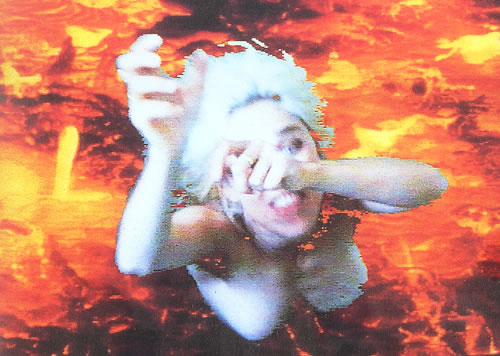
吸允我的大海,1994/96,录像
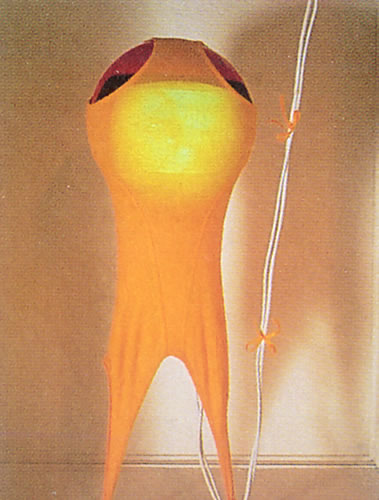
整理印象,1993,录像
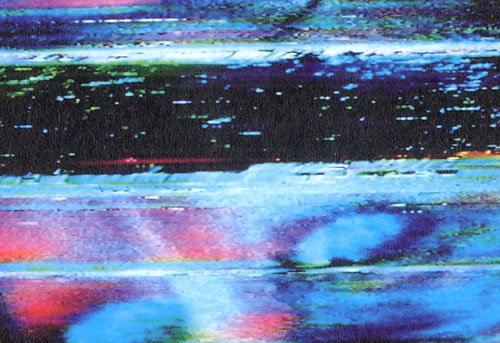
忘我在熔岩中,1994,录像
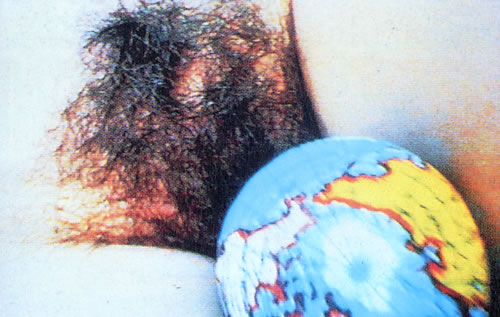
皮皮劳蒂之错,1988,12分钟录像

我是这首歌的受害者,1995,4分钟录像

一切都成往事,1997,录像
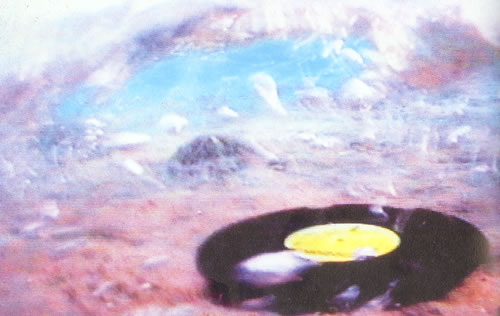
PIMPLE PORNO,1992,12分钟录像
【视频】I'm Not the Girl Who Misses
Much 1986
The opening titles are displayed
against an intense red background, the camera closes in on Pipilotti,
who, dressed in a very low-cut black dress dances before the camera singing
at the top of her voice “I’m not the Girl Who Misses Much”, words taken
(and altered slightly) from a John Lennon song “Happiness is a Warm Gun”.
The picture is hazy and the sound distorted. The zooms are Jerky, back
and forth and the picture shudders every now and again and the images
are absolutely swamped in colour. As she sings the same line over and
over again the exaggerated movements of her stamping silhouette redouble
and a bright red blotch just below her heavily made-up lips becomes the
focus of attention. Some camera angles give the impression that the performer
is floating in the red that drenches the rest of the screen. Many ingredients
of this video clip are to be found in her later piece – these being the
pre-eminence of pop music which is an easily identified universal reference,
the childish simplicity which is easy to relate to our culture (here an
interpretation), the burlesque humour, agility, repetition, and the emphatically
feminine view of the universe, with acid colour, pretty dresses and make-up.
In this clip Pipillotti celebrates the body, its energy, its vitality
and the power of human senses, while embodying the character in Lennon’s
song. Here she develops a form of clip which as a perfect example of porno-pop
image culture also makes a statement about the sexism of MTV. It is a
parodic work. The sound and the movements go beyond the bounds of the
film capability (the protagonist leaves the picture and the sound pitch
oscillates from extreme highs to extremes lows making the sound inaudible
to the human ear). Parts which are speeded up and slowed down evoke the
zapping culture. The feminine qualities of the films are exaggerated in
grotesque form. She has bright red lips, naked breasts over the top of
her low-cut dress. Pipilotti rist occupies the middle ground, between
art culture and politics, and she really tries to confuse the two codes.
By the shortness of the clip and the simplicity of the idea, Pipilotti
Rist avoids common pitfalls of the demonstration and makes I’m Not the
Girl Who Misses Much a pioneering work illustrating the mix of cultures
which prevailed in the nineteen nineties.
【视频】Pickelporno
1992
Pipolotti’s objective in this video was to visualise sexual arousal.
To do this she used a specially adapted piece of filming equipment – a
small surveillance camera. The camera is attached to the stem of a flower
and attached to the body of a couple who appear to be making love. The
outlines of their bodies are marked by small objects and clothes which
evoke the symbolic universality of erotic imagery metaphorically (shell,
flowers) and which, as accessories to the visual and erotic pleasure felt
by those viewing the film, also provide visual variations. The film centres
on a narrative where a couple first meet in a sort of hangar. The couple
are then seen lying naked on white sheets and then caressing in a series
of images. Then a montage of simplistic metaphors evoking orgasm (volcano
erupting, rapid watercourse) follows these images. The fish-eye image
which is slightly unstable and is bathed in intense colour (turquoise,
vibrant orange, incandescent pink and overexposed white) is of interest
as a truly tactile vision of the body – the skin and the hair are filmed
extremely close up and are seen as strange trembling structures. Parts
of the body like the feet, the paragon of traditional fetishism, and the
eye, the mirror of the soul, become visual objects in themselves. The
beauty of the feminine body looses its sacred aura, graphically presented
in relation to its direct role in the search for a carnal relationship
free of any kind of constraint (as opposed to ideal beauty which is disembodied
and constrained). The music throughout structures the erotic progression.
Pipilotti is libertarian and humorous and, from time to time, the graphic
superimposition of an oblong shape with eye-lash type lines round the
edges, evokes the eye as well as the mouth or the vagina, closing up on
the images, in such a way as to evoke the action of devouring and of going
blind. Quite naturally, the film finishes with an ultra-rapid montage
of figurative images of fruits and red, yellow and white tints of colour,
before ending with a jazzy tune and a shot of glistening water. Rist has
often commented that this film was an attempt at establishing female erotic
cultural imagery, and at making the man’s body an object of desire that
is both creative and positive. The question of whether this film appeared
pornographic seemed trivial to Pipilotti as the main aspect of the film
was the sheer visual invention. The immense success of Pickelporno (Pimple
porno) owes much to its plastic quality which breaks from the norm and
its direct treatment of the subject of sexual relations. The bodies are
exhibited but such is the extent of the films inventiveness, claims of
voyeurism or pornography cannot be taken seriously. Humour remains omnipresent
throughout the film especially in metaphoric orgasm sequences, which are
highly stereotypical, but whose visual quality nevertheless transcends
this banality and represents jubilation – contagious jubilation which
this video communicates to each of its viewers. (LLH)
【视频】Entslastlungen
Pipilolottti Fehler 1988
A nursery rhyme or a poem· displayed over a royal blue background the
words “I see. You see. I see you seeing. You see me seeing. I want to
show what I see. You want to show what you see. Nirvana in the rose garden”.
Then the sound starts, a powerful woman’s voice repeats the words after
they are written on the screen, singing them in German. The enunciation
of each phase is marked by a drum roll. Images also appear very abruptly
– the face of Pipilotti, dirty, hatched with white lines and saturation
blotches. Then the same nursery rhyme appears again displayed on a blue
background, this time in English. And the same voice repeats the line
in German in almost exactly the same way as before. We gradually distinguish
the images of a concert (the titles tell us that this group is the Reines
Prochaines, the musical performance group that Pipilotti established,
and which she had belonged to for many years. The tone changes and a new
text appears in English “Are you good, are you bad. Are you big, are you
small” and a ritonello on the electric organ plays at the same time. The
image makes a central superimposed rectangle appear, in which we see Pipilotti
outside in the middle of garden amidst huge flowers. Suddenly she falls,
collapsing as if fainting. Further away on the side-walk in the middle
of a square she falls again. The film closes with a firework, accompanied
by the thunderous music provided by the Reines. Translated the title of
the film means Pipilotti’s faults (appeasement). The texts point us towards
a critical perception of visual elements, the underline the absolute subjectivity
of the view, and ironies about a paradise of shared visions. Moreover
the musical performance of the Reines Prochaines is based (as with all
their concerts) on the subversive usage of the most common visual form,
la television. With the stereotype of the muscular rocker and the sexy
singer, the Reines oppose provocative female groups, inasmuch as they
can barely sing or play at all and produce songs with politically radical
lyrics (or totally na·ve lyrics). The faults of Pipilotti – the faults
of all little girls (remember here that Charlotte Rist was called Pipilotti
by analogy with the heroin of her childhood, Pippi Longstocking) are absolutions
at the famous downfalls, from which a new woman might be born. This video
which is also a bit cryptic reflects in mirror like fashion the key elements
of Pipilloti’s work – music, visual art, individual and collective production
without defining any clear boundaries. (LLH)
【视频】Blutclip
1993
The images presented in blutclip (blood clip) continue in the vein of
Pickelporno (pimple porno) ; A mobile camera provides a sequence of close-ups
of Pipilotti’s naked body, lying in a forest covered with cheap, coloured
glass jewellery. Part of a song by Sophisticated Boom Boom sung by women
and young girls provides the sound-track. The screen then shows menstrual
blood running down Pipilotti’s leg to her feet with graphically animated
cosmic images of the moon, earth and planets behind. This video clip is
a celebration of the female body and its reproductive function. The style
known as kitsch which dominates this clip is opposed to the crudity of
menstruation images, which are culturally probably the most taboo of all
images except with pornographers and feminists. Kitsch is merely an ironic
element, which is popular and typically aesthetically pleasing to women,
in opposition to what is regarded as good taste to the more sober, culturally
domineering men. In a few minutes Pipilotti succeeds in linking kitsch
fantasy with the feminist mythology of blood; by lying in a forest she
evokes fairy tales, and many wolf and ogre devourers of young girls, by
adorning herself as the cartoon princess, and by placing her bloody body
at the centre of the universe, once again she plays with the macrocosm
and microcosm analogy, and by making it a video-clip, she celebrates the
energy and power of the female body without pathos and without didacticism.
